Organic Petrologic Characterization and Paleoenvironmental Analysis of Permian Shale in Northeast Sichuan Province, China
Abstract
1. Introduction
2. Geological Settings
3. Materials and Methods
3.1. Shale Samples
3.2. Total Organic Carbon
3.3. Organic Petrology
3.4. Primary and Trace Elements
3.5. Laser Raman
4. Experimental Results
4.1. Organic Petrological Characteristics
4.2. Trace Element Characteristics and Palaeoenvironmental Significance
4.3. Organic Matter Maturity
5. Discussion
5.1. Palaeodepositional Environments
5.1.1. Palaeobathymetric Characteristics
5.1.2. Palaeosalinity Characteristics
5.1.3. Palaeoclimatic Characteristics
5.1.4. Paleoredox Characterization
5.2. Types and Characteristics of Organic Microcomponents
6. Conclusions
Author Contributions
Funding
Institutional Review Board Statement
Informed Consent Statement
Data Availability Statement
Acknowledgments
Conflicts of Interest
References
- Jarvie, D.M.; Hill, R.J.; Ruble, T.E.; Pollastro, R.M. Unconventional shale-gas systems: The Mississippian Barnett Shale of northcentral Texas as one model for thermogenic shale-gas assessment. AAPG Bull. 2007, 91, 475–499. [Google Scholar] [CrossRef]
- Loucks, R.G.; Ruppel, S.C. Mississippian Barnett shale: Lithofacies and depositional setting of a deep-water shale-gas succession in the Fort Worth basin, Texas. AAPG Bull. 2007, 91, 579–601. [Google Scholar] [CrossRef]
- Guo, X.S.; Hu, D.F.; Li, Y.P.; Liu, R.B.; Wang, Q.B. Geological features and reservoiring mode of shale gas reservoirs in Longmaxi Formation of the Jiaoshiba area. Acta Geol. Sin.-Engl. Ed. 2014, 88, 1811–1821. [Google Scholar] [CrossRef]
- Jin, Z.J.; Hu, Z.Q.; Gao, B.; Zhao, J.H. Controlling factors on the enrichment and high productivity of shale gas in the Wufeng Longmaxi Formation, southeastern Sichuan Basin. Earth Sci. Front. 2016, 23, 1–10. [Google Scholar]
- Liu, H.L.; Wang, H.Y.; Fang, C.H. The formation mechanism of over-pressure reservoir and target screening index of the marine shale in the South China. Earth Sci. Front. 2016, 23, 48–54. [Google Scholar]
- Nie, H.K.; Li, D.H.; Liu, G.X.; Lu, Z.Y.; Wang, H.; Wang, R.Y.; Zhang, G.R. An overview of the geology and production of the Fuling shale gas field, Sichuan Basin, China. Energy Geosci. 2020, 1, 147–164. [Google Scholar] [CrossRef]
- Tan, J.; Horsfield, B.; Fink, R. Shale gas potential of the major marine shale formations in the upper Yangtze platform, south China, Part III: Mineralogical, Lithofacial, petrophysical, and rock mechanical properties. Energy Fuels 2014, 28, 2322–2342. [Google Scholar] [CrossRef]
- Zhang, K.; Song, Y.; Jiang, S.; Jiang, Z.; Jia, C.; Huang, Y.; Wen, M.; Liu, W.; Xie, X.; Liu, T. Mechanism analysis of organic matter enrichment in different sedimentary backgrounds: A case study of the Lower Cambrian and the Upper Ordovician-Lower Silurian, in Yangtze region. Mar. Pet. Geol. 2018, 99, 488–497. [Google Scholar] [CrossRef]
- Cao, T.T.; Song, Z.G.; Wang, S.B.; Cao, X.X.; Li, Y.; Xia, J. Characterizing the pore structure in the silurian and permian shales of the Sichuan Basin, China. Mar. Petrol. Geol. 2015, 61, 140–150. [Google Scholar] [CrossRef]
- Cao, T.T.; Xu, H.; Liu, G.X.; Meng, M.; Cao, Q.G.; Yu, Y. Factors influencing microstructure and porosity in shales of the WufengLongmaxi formations in northwestern Guizhou, China. J. Pet. Sci. Eng. 2020, 181, 107181. [Google Scholar] [CrossRef]
- Nie, H.; Zhang, J.; Jiang, S. Types and characteristics of the lower silurian shale gas reservoirs in and around the Sichuan basin. Acta Geol. Sin.-Engl. Ed. 2017, 89, 1973–1985. [Google Scholar]
- Tian, H.; Pan, L.; Xiao, X.; Wilkins, R.; Meng, Z.; Huang, B. A preliminary study on the pore characterization of Lower Silurian black shales in the Chuandong Thrust Fold Belt, southwestern China using low pressure N2 adsorption and FE-SEM methods. Mar. Pet. Geol. 2013, 48, 8–19. [Google Scholar] [CrossRef]
- Wang, C.; Zhang, B.; Lu, Y.; Shu, Z.; Lu, Y.; Bao, H.; Meng, Z.; Chen, L. Lithofacies distribution characteristics and its controlling factors of shale in Wufeng Formation-Member 1 of Longmaxi Formation in the Jiaoshiba Area. Pet. Res. 2018, 3, 306–319. [Google Scholar] [CrossRef]
- Wang, Y.; Liu, L.; Zheng, S.; Luo, Z.; Sheng, Y.; Wang, X. Full-scale pore structure and its controlling factors of the WufengLongmaxi shale, southern Sichuan Basin, China: Implications for pore evolution of highly overmature marine shale. J. Nat. Gas Sci. Eng. 2019, 67, 134–146. [Google Scholar] [CrossRef]
- Xu, Z.; Shi, W.; Zhai, G. A rock physics model for characterizing the total porosity and velocity of shale: A case study in Fuling area, China. Mar. Pet. Geol. 2019, 99, 208–226. [Google Scholar] [CrossRef]
- Yang, F.; Ning, Z.F.; Wang, Q.; Zhang, R.; Krooss, B.M. Pore structure characteristics of lower Silurian shales in the southern Sichuan Basin, China: Insights to pore development and gas storage mechanism. Int. J. Coal Geol. 2016, 156, 12–24. [Google Scholar] [CrossRef]
- Milliken, K.L.; Rudnicki, M.; Awwiller, D.N.; Zhang, T. Organic matter-hosted pore system, Marcellus formation (Devonian), Pennsylvania. AAPG (Am. Assoc. Pet. Geol.) Bull. 2013, 97, 177–200. [Google Scholar] [CrossRef]
- Peng, N.; He, S.; Hu, Q.H.; Zhang, B.Q.; He, X.P.; Zhai, G.Y.; He, C.C.; Yang, R. Organic nanopore structure and fractal characteristics of Wufeng and lower member of Longmaxi shales in southeastern Sichuan, China. Mar. Pet. Geol. 2019, 103, 456–472. [Google Scholar] [CrossRef]
- Wu, L.Y.; Hu, D.F.; Lu, Y.C.; Liu, R.B.; Liu, X.F. Advantageous shale lithofacies of Wufeng Formation-Longmaxi Formation in Fuling gas field of Sichuan Basin, SW China. Pet. Explor. Dev. 2016, 43, 189–198, (In Chinese with English Abstract). [Google Scholar] [CrossRef]
- Zou, C.; Dong, D.; Li, J.Z.; Wang, S.J.; Li, X.J.; Wang, Y.M.; Li, D.H.; Huang, J.L. Shale gas resource potential and prospect of exploration and development. Geol. Bull. 2011, 30, 324–336. [Google Scholar]
- Wang, Z. Practice and cognition of shale gas horizontal well fracturing stimulation in Jiaoshiba of Fuling area. Oil Gas Geol. 2014, 35, 425–430. [Google Scholar]
- Wang, S. The Tectonic Characteristics of Changning Area, South of Sichuan and Crack Characteristics of Longmaxi Formation of Silurian System; Chengdu University of Technology: Chengdu, China, 2014. [Google Scholar]
- Zhou, D. Shale Gas Reservoiring Conditions and Favorable Area Preferred in Lower Paleozoic in Sichuan Weiyuan Area; Chengdu University of Technology: Chengdu, China, 2013. [Google Scholar]
- Guo, T.; Zhang, H. Formation and enrichment mode of Jiaoshiba shale gas field, Sichuan Basin. Pet. Explor. Dev. 2014, 41, 28–36. [Google Scholar] [CrossRef]
- Liu, Z.B.; Li, P.; Liu, G.X.; Li, X.; Liu, H.T.; Wang, P.W.; Hao, J.Y.; Li, Q.W. Organic geochemical characterization of the Lower Permian shale in the northeastern Sichuan Basin, China: Implication for shale gas exploration potential. Mar. Pet. Geol. 2019, 106, 161–172. [Google Scholar]
- Guo, Z.H.; Hu, G.Y.; He, K.; Mi, J.K.; Tian, L.J.; He, F.; Guo, C.Y.; Lu, M.D. Geochemical characteristics and depositional environments of hydrocarbon source rocks of the Permian Dalong Formation in northern Sichuan. Rocky Reserv. 2023, 35, 139–152. [Google Scholar]
- Lian, M.L.; Liu, D.D.; Lin, R.Q.; Wang, Y.S.; Shi, F.L.; Cai, J.Y.; Fan, Q.Q.; Zhang, Z.Y.; Zhao, F.P.; Chen, Y.; et al. Depositional environments and organic matter enrichment mechanism of Wufeng Formation-Longmaxi Formation shales in northern Guizhou. J. Cent. South Univ. (Nat. Sci. Ed.) 2022, 53, 3756–3772. [Google Scholar]
- Xie, Z.Y.; Yang, C.L. Geochemical characteristics and genesis of the Middle Devonian and the Middle Permian natural gas in the Sichuan Basin, China. Nat. Gas Geosci. 2020, 5, 185–198. [Google Scholar] [CrossRef]
- Xie, S.; Zhang, J.; Gan, D. Organic geochemical characterization of the Lower Permian black shales in the northeastern Sichuan Basin, South China. Mar. Pet. Geol. 2017, 80, 165–175. [Google Scholar]
- Deng, S.; Tang, X.; Zhang, Y.; Li, L.; Su, B.; Li, X. Organic Geochemical Characteristics and Shale Gas Potential of the Lower Permian Longtan Formation, Northeastern Sichuan Basin, China. Energy Fuels 2020, 34, 875–888. [Google Scholar]
- Cao, Y.; Tang, X.; Zhang, Y.; Luo, P.; Kang, X.; Yue, D. Organic geochemical characteristics and depositional environment of Lower Permian shale in Jiaoshiba area, northeastern Sichuan Basin, China: Implications for shale gas potential. J. Pet. Sci. Eng. 2019, 173, 722–735. [Google Scholar]
- Zhang, Y.; Tang, X.; Hu, P.; Cao, Y.; Deng, S. Organic and inorganic geochemical characteristics of the Lower Permian shale in eastern Sichuan Basin, China: Implications for shale gas potential. J. Nat. Gas Sci. Eng. 2018, 62, 10–21. [Google Scholar]
- Hu, P.; Wang, J.; Zhang, J.; Deng, J.; Jia, C.; Ma, J.; Huang, S. Organic Geochemistry and Depositional Environment of Lower Permian Shale in the Jiaoshiba Area, Northeastern Sichuan Basin, China. Chin. J. Geochem. 2017, 36, 432–443. [Google Scholar]
- Ma, J.; Hu, P.; Zhang, J.; Huang, S.; Jia, C. Organic geochemical properties and source rock potential of the Lower Permian shale in the Jiaoshiba area, northeastern Sichuan Basin, Southwest China. Arab. J. Geosci. 2019, 12, 340. [Google Scholar]
- Zhai, G.M. Petroleum Geology of China; Petroleum Industry Press: Beijing, China, 1992. (In Chinese) [Google Scholar]
- Li, J.; Xie, Z.Y.; Dai, J.X.; Zhang, S.C.; Zhu, G.Y.; Liu, Z.L. Geochemistry and origin of sour gas accumulations in the northeastern Sichuan Basin, SW China. Org. Geochem. 2005, 36, 1703–1716. [Google Scholar] [CrossRef]
- Huang, J.Q. On Major Tectonic Units of China; Geological Press: Beijing, China, 1954; 161p. [Google Scholar]
- Wang, Y.Y.; Liu, H.Y.; Wen, Y.C.; Yang, Y.; Zhang, J. Distribution law, exploration method and prospect of the oolitic beach reservoirs in the Feixianguan formation in northeast Sichuan Basin. Nat. Gas Ind. 2002, 22, 14–18. [Google Scholar]
- Wang, B.J. The Sichuan Hydrocarbon Province; Volume 10 of Petroleum Geology of China; Petroleum Industry Press: Beijing, China, 1989; p. 516. [Google Scholar]
- Ma, Y.S. Petroleum geology of the Puguang sour gas field in the Sichuan Basin, SW China. Mar. Pet. Geol. 2008, 25, 357–370. [Google Scholar] [CrossRef]
- Wang, A.; Xiao, K.H.; Liu, Z.Q.; Huang, Y.Q. Sedimentary facies of the second and third sections of the Yuan Dam in northeastern Sichuan and their effect on reservoir control. Geoscience 2023, 1–16. [Google Scholar]
- Liu, S.; Fan, C.; Zhang, B.; Zhang, Y.; Wang, W.; Luo, B.; Bai, X. Characteristics of the Lone Peak Section of the Middle Permian Maokou Formation in the eastern Sichuan Basin and its petroleum geological significance. Oil Gas Geol. 2023, 44, 993–1008. [Google Scholar]
- Jiang, D.; Li, P.; Zou, H. Development characteristics of natural fractures of Jurassic shale in Yuanba area of northeast Sichuan and their influence on shale oil and gas enrichment and preservation. Geoscience 2023, 1–16. [Google Scholar]
- Zheng, A.; Meng, Z.; Li, K.; Liu, L.; Liu, Y.; Peng, G.; Yi, Y.; Cai, J. Longitudinal heterogeneity characteristics of Permian Wujiaping Shale reservoirs in Hongxing area of eastern Sichuan and their main factors for development. Nat. Gas Geosci. 2023, 34, 1500–1514. [Google Scholar]
- Guo, J.; Hu, G.; He, K. Geochemical characteristics and sedimentary environment of source rocks of the Permian Dalong Formation in northern Sichuan. Lithol. Reserv. 2023, 35, 139–152. [Google Scholar]
- Heng, L.; Tong, Z.; Qiao, H. The Upper Permian Dallong Formation-Wujiaping Formation in the Wangjiang Depression in the Lower Yangtze Area is rich in organic shale element characteristics and paleoenvironmental significance. Nat. Gas Explor. Dev. 2023, 46, 74–83. [Google Scholar]
- Zhou, Y.; Rui, X.; Fan, B.F. Pore development characteristics of Jurassic continental shale in Sichuan Basin. J. Xi’an Shiyou Univ. (Nat. Sci. Ed.) 2023, 38, 27–37+80. [Google Scholar]
- Liu, S.; Gao, P.; Xiao, X.; Liu, R.; Qin, J. Study on organic petrological characteristics of black shale in Wufeng-Longmaxi Formation in Sichuan Basin. Geoscience 2022, 36, 1281–1291. [Google Scholar]
- Ding, J.; Sun, J.; Zhang, J.; Yang, X.; Shi, G.; Wang, R.; Huang, B.; Li, H. Characteristics of shale biomarker compounds in the Dalong Formation in southern Anhui and their geological significance. J. Earth Sci. 2023, 48, 235–251. [Google Scholar]
- Wang, L.; Zhou, H.; Shang, F.; Zhou, X. Geochemical characteristics of black shale elements and sedimentary paleoenvironment restoration in the Cretaceous Qingshankou Formation in northern Songliao Basin. Chin. J. Geol. 2022, 57, 156–171. [Google Scholar]
- Shu, Z.; Zhou, L.; Li, X.; Liu, H.; Zeng, Y. Geological characteristics and exploration and development prospects of continental shale condensate gas reservoir in the Dongyue Temple section of the Jurassic artesian well formation in the Fuxing area of eastern Sichuan Basin. Oil Gas Geol. 2021, 42, 212–223. [Google Scholar]
- Wang, W.; Shi, W.; Fu, X.; Chen, C. Potential and direction of shale gas exploration in the Dalong Formation of the Permian of northern Sichuan. Pet. Geol. Exp. 2020, 42, 892–899+956. [Google Scholar]
- Liu, Z.; Yuan, B.; Huang, X. Dimigraphic division and comparison of the Permian stratigraphy of Maoertang, Jiange County, northwest Sichuan. ChengDu Univ. Technol. Acad. J. Cent. 2020, 47, 257–273. [Google Scholar]
- Zou, C.; Yang, Z.; Wang, H. “Finding oil from sources”: On unconventional continental large-scale shale oil and gas fields in the Sichuan Basin. Acta Geol. Sin. 2019, 93, 1551–1562. [Google Scholar]
- Zhang, K.; Wang, S.; Yang, Y.; Gong, Y.; Zhu, D.; Yang, Y. Development characteristics of dolomite in the Maokou Formation in Puguang area of northeastern Sichuan. Mar. Orig. Pet. Geol. 2019, 24, 20–26. [Google Scholar]
- Zhang, Y.; Xu, S.; Cheng, H.; Lin, L.; Dong, Y.; Yu, Y.; Zhang, Y. Geochemical characteristics of Qixia Formation and its paleoenvironmental significance in Wangcang area of northeastern Sichuan. Pet. Geol. Exp. 2018, 40, 210–217. [Google Scholar]
- GB/T 19145-2022; Determination of total Organic Carbon in Sedimentary Rocks. State Administration of Market Supervision and Administration of China and the National Standardization Administration of China: Beijing, China, 2022.
- SYT 5124-2012; Method for Determining the Reflectivity of Specular Bodies in Sedimentary Rocks. National Energy Administration of China: Beijing, China, 2012.
- SY/T 6414-2014; Microcomponent Identification and Statistical Methods for Whole-Rock Light Sheets. National Energy Administration of China: Beijing, China, 2014.
- Murray, R.W. Chemical Criteria to identify the depositional environment of chert: Deneral principles and applications. Sediment. Geol. 1994, 90, 213–232. [Google Scholar] [CrossRef]
- Borjigin, T.; Lu, L. Formation, preservation and connectivity control of organic pores in shale. Pet. Explor. Dev. 2021, 4, 84. [Google Scholar] [CrossRef]
- Yang, M.; Zuo, Y.; Fu, X.; Qiu, L.; Li, W.; Zhang, J.; Zheng, Z.; Zhang, J. Paleoenvironment of the Lower Ordovician Meitan Formation in the Sichuan Basin and Adjacent Areas, China. Minerals 2022, 12, 75. [Google Scholar] [CrossRef]
- Liu, D.; Xiao, X.; Tian, H.; Tian, H.; Min, Y.; Zhou, Q.; Cheng, P. Methodology and geological application of Raman spectroscopic parameters of solid organic matter to calculate the degree of thermal evolution of samples. Sci. Bull. 2013, 58, 1228–1241. [Google Scholar]
- Wang, Y.; Qiu, N.; Xie, X. Integrated assessment of thermal maturity of the Upper Ordovician–Lower Silurian Wufeng–Longmaxi shale in Sichuan Basin, China. Mar. Pet. Geol. 2019, 100, 447–465. [Google Scholar] [CrossRef]
- Liu, H.; Tong, Z.; Qiao, H.; Wang, S. Elemental characteristics and paleoenvironmental significance of organic-rich shale from the Upper Permian Dalong Formation—Wujiaping Formation, Wangjiang Argumentary Depression, Lower Yangzi Region. Nat. Gas Explor. Dev. 2023, 46, 74–83. [Google Scholar]
- Wang, Y.; Qiu, N.; Xie, X.; Ni, T.; Cheng, H.; Zou, Z.; Ma, Z.; Shen, B.; Borjigin, T. Thermal maturity calibration of extremely high-mature pre-Devonian strata: A case study from the Lower Cambrian Qiongzhusi Formation in the Sichuan Basin, South China. Geoenergy Sci. Eng. 2023, 222, 211411. [Google Scholar] [CrossRef]
- Tenger, B.; Qing, J.; Fu, X.; Yang, Y.; Xie, X. Evaluation of source rocks of the Wujiaping Formation of the Upper Permian in northeastern Sichuan. J. Palaeogeogr. 2010, 12, 334–345. [Google Scholar]
- Li, J.; Zhou, S.; Fu, D.; Li, Y.; Ma, Y.; Yang, Y. Oil-source rock correlation for paleo-oil reservoir in the Puguang gas field, northeast Sichuan Basin, southwest China. Pet. Sci. Technol. 2016, 34, 578–586. [Google Scholar] [CrossRef]
- Chen, H.; Xie, X.; Hu, C. Geochemical characteristics of Late Permian sediments in the Dalong Formation of the Shangsi Section, Northwest Sichuan Basin in South China: Implications for organic carbon-rich siliceous rocks formation. J. Geochem. Explor. 2012, 112, 35–53. [Google Scholar] [CrossRef]
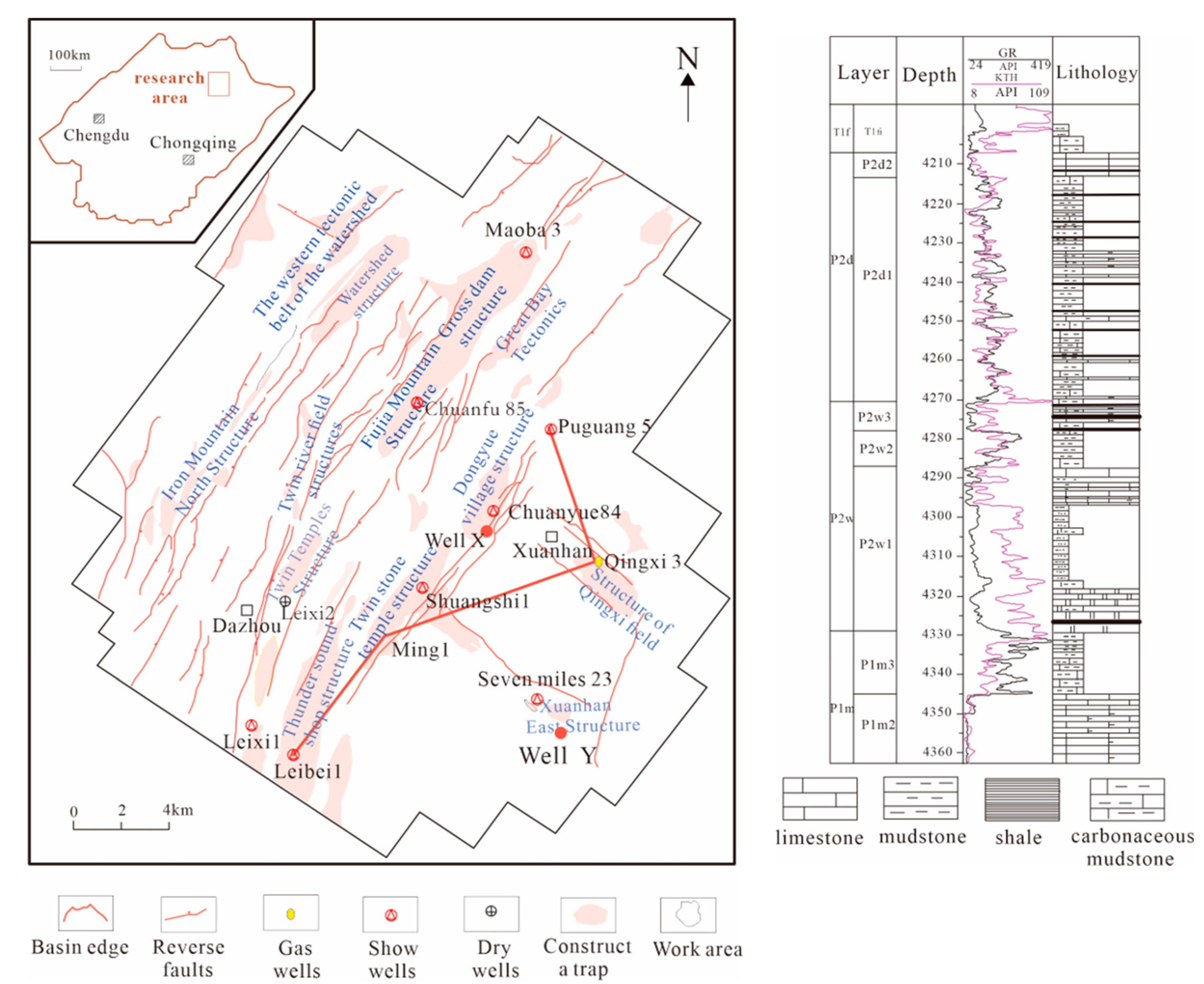
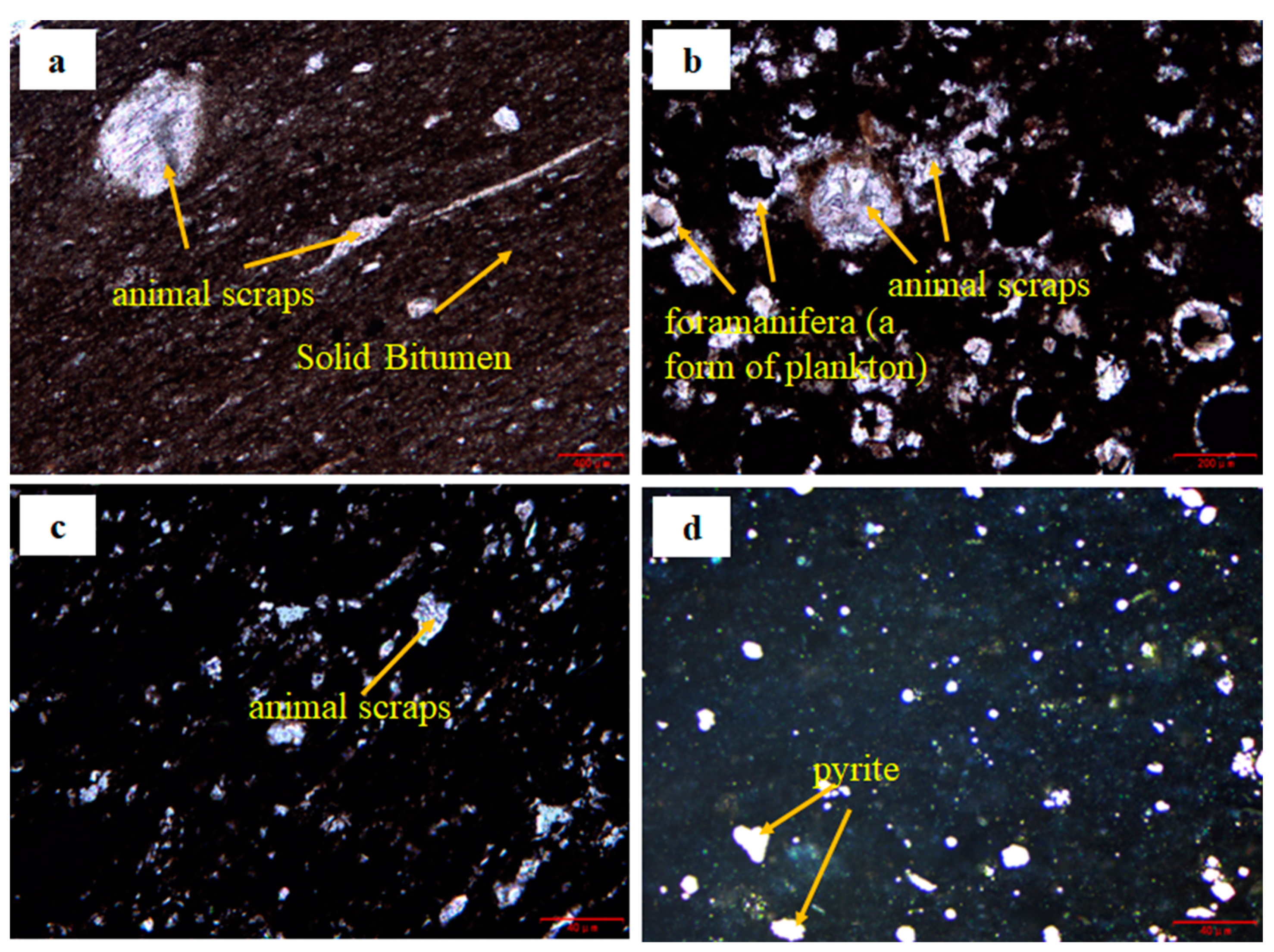
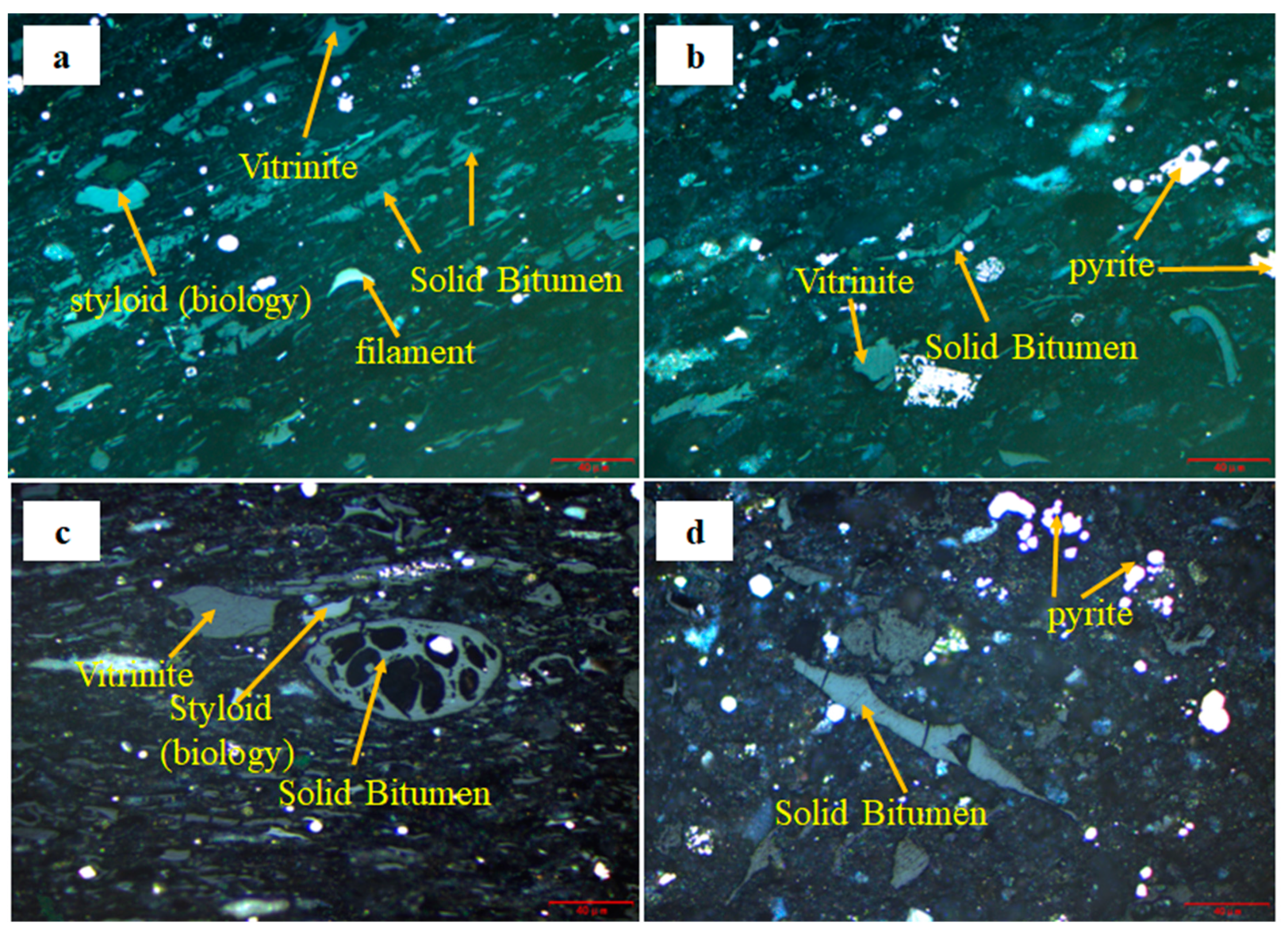
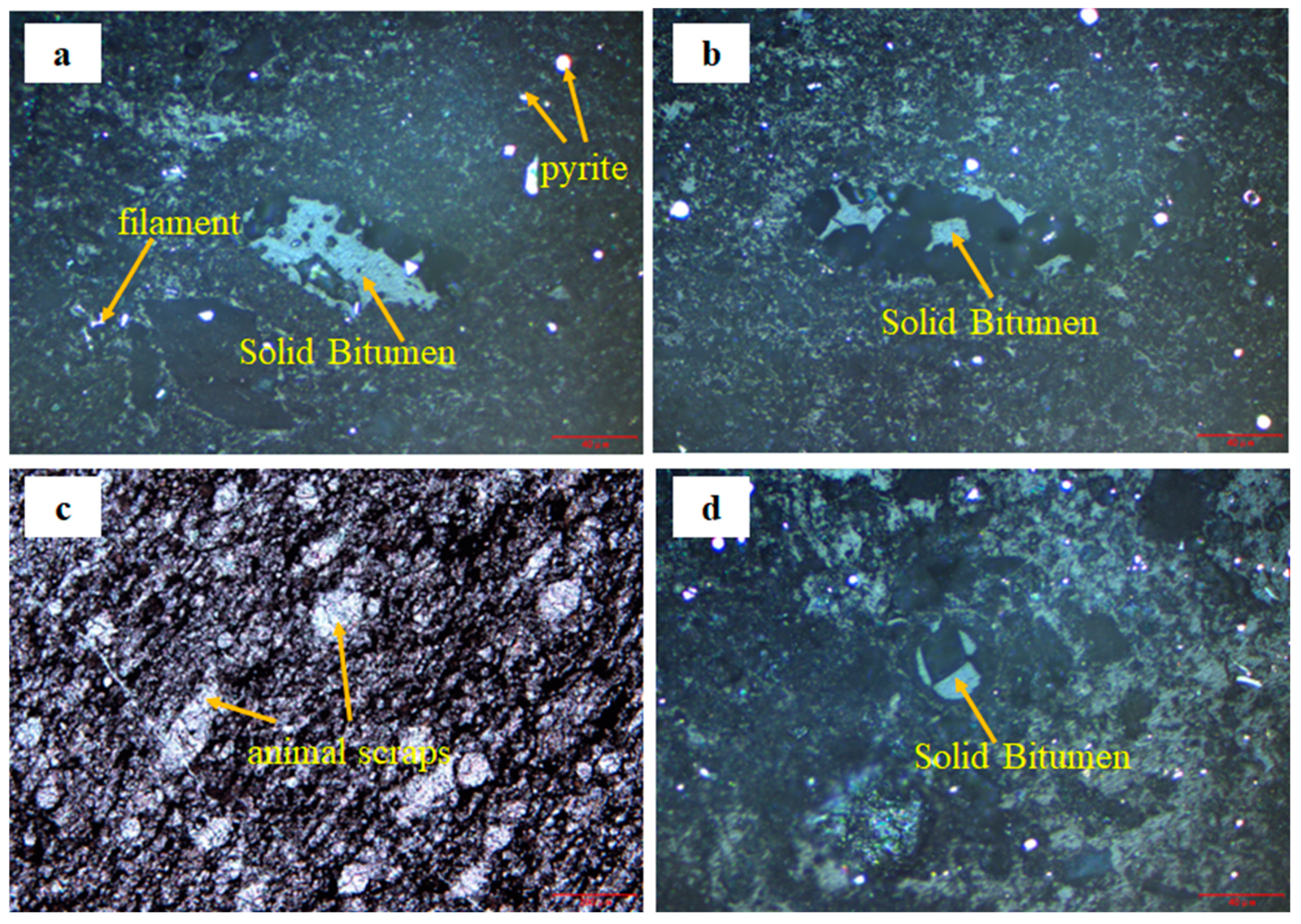

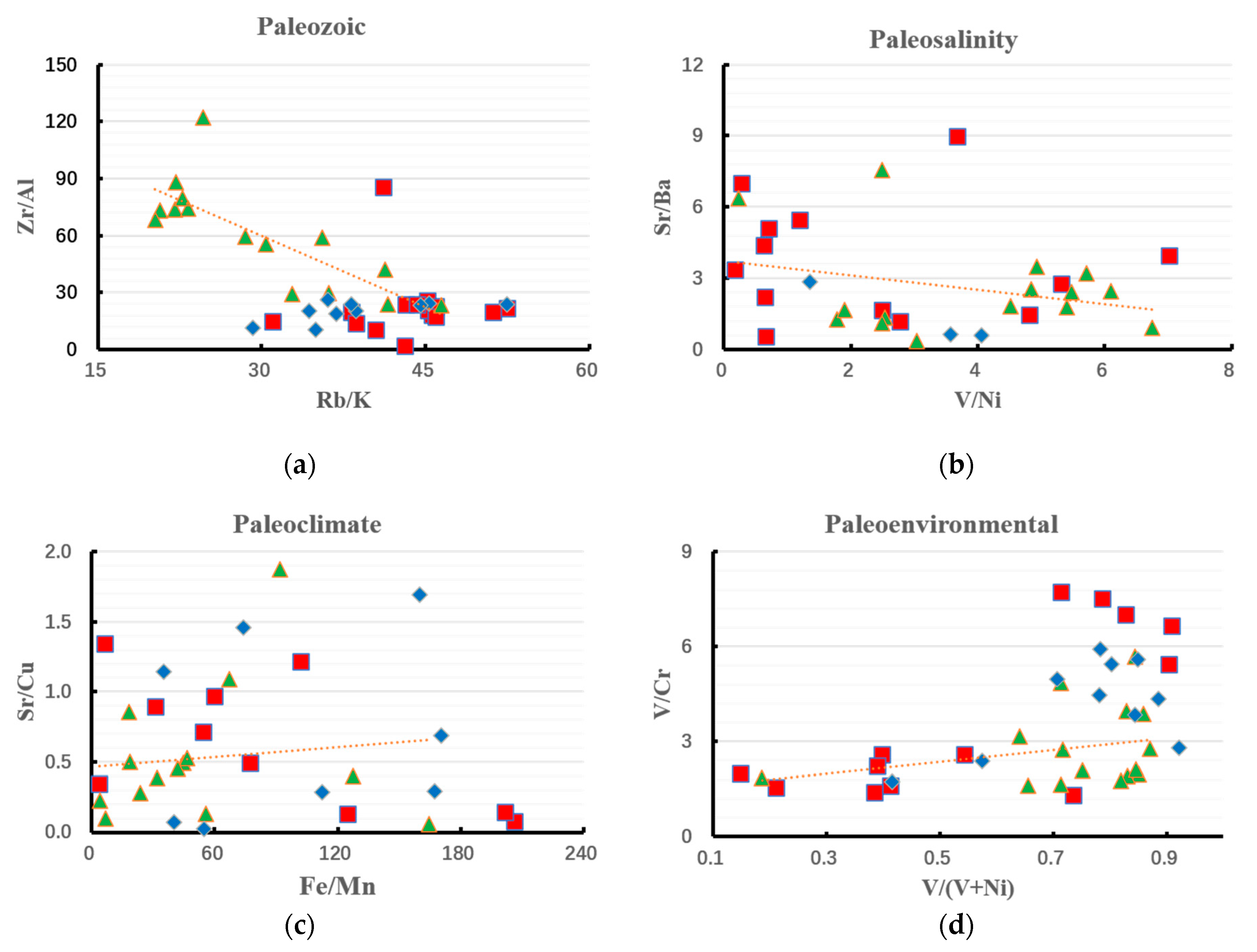
| Sample Number | Wells | Sampling Depth/m | Stratum | TOC (%) |
|---|---|---|---|---|
| X-1 | Well X | 4213.35 | Dalong Formation | 1.23 |
| X-2 | 4216.25 | 1.65 | ||
| X-3 | 4224.91 | 2.60 | ||
| X-4 | 4229.1 | 1.63 | ||
| X-5 | 4234.69 | 2.49 | ||
| X-6 | 4243.1 | 2.87 | ||
| X-7 | 4244.71 | 5.03 | ||
| X-8 | 4247.13 | 8.00 | ||
| X-9 | 4250 | 0.80 | ||
| X-10 | 4253.69 | 5.07 | ||
| X-11 | 4261.76 | 11.20 | ||
| X-12 | 4263.09 | 6.10 | ||
| X-13 | 4266.63 | 7.75 | ||
| X-14 | 4268.47 | 6.55 | ||
| X-15 | 4270.39 | 0.83 | ||
| X-16 | 4278.59 | Wujiaping Formation | 7.63 | |
| X-17 | 4280.78 | 3.92 | ||
| X-18 | 4290.4 | 5.98 | ||
| X-19 | 4296.87 | 0.57 | ||
| X-20 | 4297.28 | 10.90 | ||
| X-21 | 4301.53 | 3.23 | ||
| X-22 | 4310.39 | 4.69 | ||
| X-23 | 4314.24 | 4.41 | ||
| X-24 | 4330.48 | Maokou Formation | 17.10 | |
| X-25 | 4331.9 | 3.60 | ||
| X-26 | 4333.75 | 5.57 |
| Sample Number | Wells | Sampling Depth/m | Stratum | TOC (%) |
|---|---|---|---|---|
| Y-1 | Well Y | 3295.6 | Wujiaping Formation | 12.27 |
| Y-2 | 3301.3 | 8.76 | ||
| Y-3 | 3304 | 16.98 | ||
| Y-4 | 3307.9 | 8.18 | ||
| Y-5 | 3308.7 | 4.78 | ||
| Y-6 | 3323.38 | 6.80 | ||
| Y-7 | 3324.38 | 14.70 | ||
| Y-8 | 3333.54 | Maokou Formation | 2.50 | |
| Y-9 | 3339.04 | 1.73 | ||
| Y-10 | 3340.54 | 1.86 | ||
| Y-11 | 3345.07 | 16.70 | ||
| Y-12 | 3350.57 | 18.20 | ||
| Y-13 | 3353.07 | 16.95 | ||
| Y-14 | 3355.47 | 13.31 |
| Stratum | Number of Samples/pc | La/Ce | Sc/Cr | Y/Ho | Sr/Cu | Sr/Ba | U/Th | Mo/U |
|---|---|---|---|---|---|---|---|---|
| Dalong Formation | 15 | 0.38~0.81 /0.57 | 0.01~0.16 /0.07 | 23.33~38.64 /30.57 | 0.08~4.17 /1.13 | 0.53~34.36 /6.53 | 0.36~63.64 /9.03 | 0.06~15.68 /5.31 |
| Maokou Formation | 10 | 1.06~1.51 /1.21 | 0~0.18 /0.04 | 26.02~46.45 /34.35 | 0.02~1.69 /0.71 | 0.57~48.81 /22.09 | 11.65~24.20 /17.89 | 1.26~7.64 /4.47 |
| Wujiaping Formation | 15 | 0.42~0.54 /0.48 | 0.01~0.25 /0.12 | 23.75~47.51 /31.36 | 0.06~1.88 /0.53 | 0.35~7.56 /2.55 | 0.17~4.84 /1.34 | 0.41~17.47 /4.11 |
| Sample Number | Sampling Depth/m | Stratum | Whole Rock Reflectance/% | |||
|---|---|---|---|---|---|---|
| Minimum Value | Maximum Values | Average Value | Measured Point | |||
| X-2 | 4216.25 | Dalong Formation | 0.93 | 1.45 | 1.14 | 22 |
| X-4 | 4229.1 | 1.33 | 1.84 | 1.52 | 32 | |
| X-6 | 4243.1 | 1.38 | 1.96 | 1.66 | 25 | |
| X-8 | 4247.13 | 1.76 | 2.28 | 1.98 | 24 | |
| X-10 | 4253.69 | 1.9 | 2.44 | 2.2 | 22 | |
| X-12 | 4263.09 | 2.02 | 2.69 | 2.42 | 42 | |
| X-14 | 4268.47 | 1.8 | 2.29 | 2.07 | 25 | |
| X-17 | 4280.78 | Wujiaping Formation | 2.14 | 2.68 | 2.57 | 18 |
| X-20 | 4297.28 | 1.61 | 2.47 | 2.01 | 22 | |
| X-22 | 4310.39 | 1.83 | 2.27 | 2 | 22 | |
| X-24 | 4330.48 | Maokou Formation | 1.99 | 2.5 | 2.25 | 35 |
| X-26 | 4333.75 | 1.25 | 1.94 | 1.46 | 44 | |
| Sample Number | Sampling Depth/m | Stratum | Whole Rock Reflectance/% | |||
|---|---|---|---|---|---|---|
| Minimum Value | Maximum Values | Average Value | Measured Point | |||
| Y-3 | 3304 | Wujiaping Formation | 1.91 | 2.32 | 2.13 | 50 |
| Y-5 | 3308.7 | 2.04 | 2.59 | 2.32 | 43 | |
| Y-6 | 3323.38 | 1.61 | 2.09 | 1.82 | 58 | |
| Y-8 | 3333.54 | Maokou Formation | 1.67 | 2.26 | 1.94 | 25 |
| Y-11 | 3345.07 | 2.07 | 2.66 | 2.47 | 68 | |
| Y-14 | 3355.47 | 1.8 | 2.43 | 2.03 | 38 | |
| Sample Number | Mt Raman | Raman Shift/cm | d(G − D)/cm | RoRmc/% | Roreality/% |
|---|---|---|---|---|---|
| X-20-1 | D | 1347.4 | 250.6 | 2.25 | 2.01 |
| G | 1598 | ||||
| X-20-3 | D | 1334.7 | 264.8 | 3 | |
| G | 1599.5 | ||||
| X-22-1 | D | 1339.4 | 258.6 | 2.67 | 2 |
| G | 1598 | ||||
| X-22-3 | D | 1336.7 | 261.3 | 2.8 | |
| G | 1598 | ||||
| Y-14-2 | D | 1342.2 | 257.5 | 2.62 | 2.03 |
| G | 1599.5 | ||||
| Y-5-3 | D | 1342.3 | 257.2 | 2.6 | 2.32 |
| G | 1599.5 |
Disclaimer/Publisher’s Note: The statements, opinions and data contained in all publications are solely those of the individual author(s) and contributor(s) and not of MDPI and/or the editor(s). MDPI and/or the editor(s) disclaim responsibility for any injury to people or property resulting from any ideas, methods, instructions or products referred to in the content. |
© 2024 by the authors. Licensee MDPI, Basel, Switzerland. This article is an open access article distributed under the terms and conditions of the Creative Commons Attribution (CC BY) license (https://creativecommons.org/licenses/by/4.0/).
Share and Cite
Jiang, C.; Xie, X. Organic Petrologic Characterization and Paleoenvironmental Analysis of Permian Shale in Northeast Sichuan Province, China. Appl. Sci. 2024, 14, 2792. https://doi.org/10.3390/app14072792
Jiang C, Xie X. Organic Petrologic Characterization and Paleoenvironmental Analysis of Permian Shale in Northeast Sichuan Province, China. Applied Sciences. 2024; 14(7):2792. https://doi.org/10.3390/app14072792
Chicago/Turabian StyleJiang, Chao, and Xiaomin Xie. 2024. "Organic Petrologic Characterization and Paleoenvironmental Analysis of Permian Shale in Northeast Sichuan Province, China" Applied Sciences 14, no. 7: 2792. https://doi.org/10.3390/app14072792
APA StyleJiang, C., & Xie, X. (2024). Organic Petrologic Characterization and Paleoenvironmental Analysis of Permian Shale in Northeast Sichuan Province, China. Applied Sciences, 14(7), 2792. https://doi.org/10.3390/app14072792






